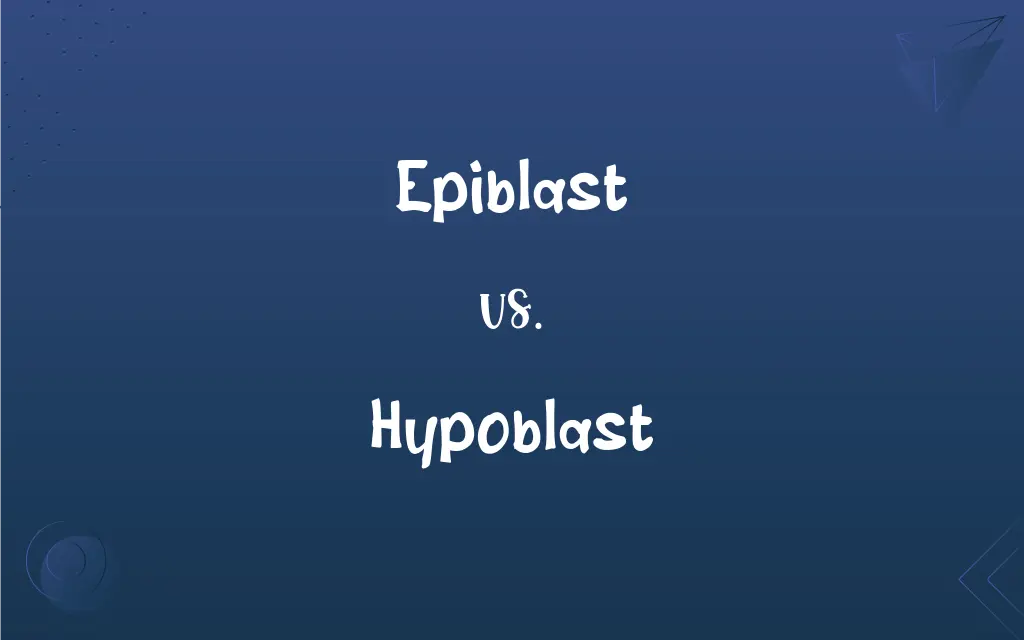Epiblast vs. Hypoblast: What's the Difference?
Edited by Aimie Carlson || By Janet White || Published on February 18, 2024
Epiblast is the upper layer of cells in the early embryo that develops into the entire body, while hypoblast forms the lower layer, contributing mainly to extraembryonic structures.

Key Differences
The epiblast is a layer of cells in the early embryo that eventually gives rise to the entire body, including all three germ layers. The hypoblast, located beneath the epiblast, primarily contributes to the formation of extraembryonic structures like the yolk sac.
During embryonic development, the epiblast cells undergo extensive differentiation, forming tissues and organs of the embryo. Hypoblast cells, however, play a more supportive role, involved in the initial stages of embryonic development but not in forming the main body structures.
Epiblast cells are pluripotent, meaning they have the potential to develop into any cell type in the body. In contrast, hypoblast cells have a more limited developmental potential, mostly contributing to the yolk sac and other support structures.
The epiblast is crucial for the formation of the amniotic sac, which protects and cushions the embryo. The hypoblast, meanwhile, helps form the blastocoel, a fluid-filled cavity within the blastocyst, playing a role in initial embryonic growth.
The epiblast is key to forming the entire organism, while the hypoblast's role is largely confined to early developmental stages and contributing to structures that support the embryo.
ADVERTISEMENT
Comparison Chart
Role in Development
Forms entire body
Forms extraembryonic structures
Location in Embryo
Upper layer
Lower layer
Cell Potency
Pluripotent
Limited developmental potential
Contribution to Germ Layers
Forms all three germ layers
Does not contribute to germ layers
Embryonic Structures Formed
Amniotic sac, tissues, organs
Yolk sac, blastocoel
ADVERTISEMENT
Epiblast and Hypoblast Definitions
Epiblast
Upper Embryo Layer.
The epiblast forms the upper layer of the embryonic disc.
Hypoblast
Supportive Layer.
The hypoblast contributes to the formation of the yolk sac.
Epiblast
Embryonic Development.
In embryonic development, the epiblast plays a central role.
Hypoblast
Early Development Role.
In early development, the hypoblast supports the embryo.
Epiblast
Pluripotent Layer.
The epiblast cells can develop into any type of body cell.
Hypoblast
Lower Embryo Layer.
Located beneath the epiblast, the hypoblast forms the lower layer.
Epiblast
Body Formation.
The entire body is derived from the epiblast.
Hypoblast
Yolk Sac Formation.
The hypoblast is crucial in forming the early yolk sac.
Epiblast
Germ Layer Origin.
All three germ layers originate from the epiblast.
Hypoblast
Blastocoel Contribution.
The hypoblast helps form the blastocoel in the embryo.
Epiblast
The outer layer of a blastula that gives rise to the ectoderm after gastrulation.
Hypoblast
See endoderm.
Epiblast
The outer layer of a blastula that, after gastrulation, becomes the ectoderm.
Hypoblast
(embryology) A type of tissue that forms from the inner cell mass and later is incorporated into the endoderm
Epiblast
The outer layer of the blastoderm; the ectoderm. See Blastoderm, Delamination.
Hypoblast
The inner or lower layer of the blastoderm; - called also endoderm, entoderm, and sometimes hypoderm. See Illust. of Blastoderm, Delamination, and Ectoderm.
Hypoblast
The inner germ layer that develops into the lining of the digestive and respiratory systems
FAQs
What is the location of the epiblast in the embryo?
It's the upper layer of the embryonic disc.
What structures does the hypoblast form?
Primarily the yolk sac and other support structures.
Are epiblast cells pluripotent?
Yes, they can become any cell type.
What does the epiblast develop into?
It develops into all body tissues and organs.
Is the hypoblast involved in placenta formation?
It plays a role in early placental development.
What happens to the hypoblast after the yolk sac is formed?
It mainly ceases to play a major role after this stage.
Can epiblast cells form the nervous system?
Yes, they can differentiate into all types of cells, including neural.
What is the role of the hypoblast in the blastocoel?
It helps in the formation and maintenance of the blastocoel.
Does the hypoblast contribute to germ layers?
No, it does not form germ layers.
Is the hypoblast involved in organ formation?
No, it's mostly involved in forming support structures.
Can the hypoblast give rise to body tissues?
No, it's limited to supporting embryonic structures.
Does the epiblast form the amniotic sac?
Yes, it contributes to the formation of the amniotic sac.
Is the epiblast visible in early pregnancy scans?
It may be visible as part of the developing embryo.
Does the hypoblast form any part of the fetus?
No, it's involved in forming extraembryonic structures only.
What is the fate of the hypoblast in later pregnancy?
It becomes less significant as the embryo develops.
Can the epiblast be used in regenerative medicine?
Its cells have potential applications in this field.
How does the epiblast contribute to gastrulation?
It forms the primary layers during gastrulation.
Do epiblast cells have a role in stem cell research?
Yes, due to their pluripotent nature.
How does the hypoblast affect embryo nutrition?
It contributes to early nutritional support via the yolk sac.
Are epiblast cells the same as embryonic stem cells?
They are similar in their pluripotency.
About Author
Written by
Janet WhiteJanet White has been an esteemed writer and blogger for Difference Wiki. Holding a Master's degree in Science and Medical Journalism from the prestigious Boston University, she has consistently demonstrated her expertise and passion for her field. When she's not immersed in her work, Janet relishes her time exercising, delving into a good book, and cherishing moments with friends and family.
Edited by
Aimie CarlsonAimie Carlson, holding a master's degree in English literature, is a fervent English language enthusiast. She lends her writing talents to Difference Wiki, a prominent website that specializes in comparisons, offering readers insightful analyses that both captivate and inform.
































































